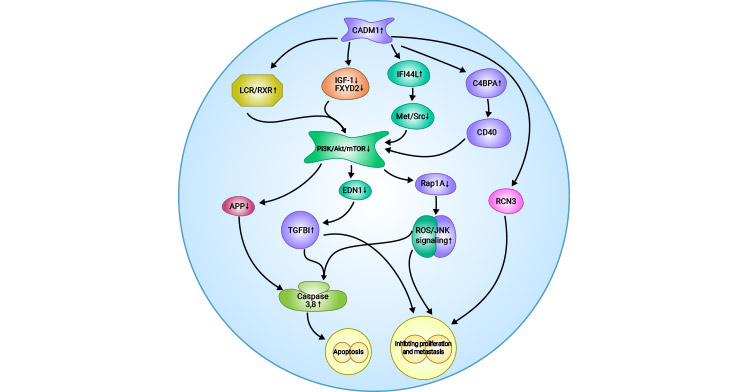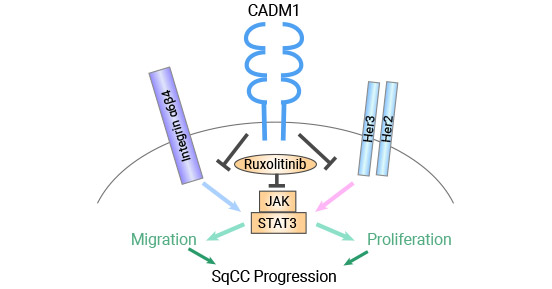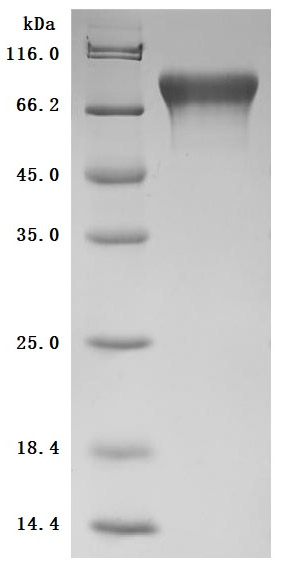CADM1/TSLC1:免疫球蛋白超家族黏附分子,一种新的TSG肿瘤抑制基因!
日期:2023-05-31 09:46:50
CADM1是一种免疫球蛋白超家族的细胞粘附分子,其在人体内广泛存在。除了存在于多种肿瘤细胞中,CADM1也存在于很多正常组织中,并发挥着多种功能。尤其值得注意的是,在多种肿瘤生长、浸润和转移过程中,CADM1具有肿瘤抑制的功能,被认为是一种新的肿瘤抑制基因(Tumor Suppressor Gene,TSG),即通过调节细胞增殖和凋亡来抑制肿瘤生长。研究发现,在许多恶性肿瘤中,CADM1启动子的甲基化导致其表达下调或缺失,从而引起癌细胞的广泛浸润和转移。
此外,CADM1抑制细胞转移的作用可能与T细胞介导的细胞免疫有关,尤其是CD8+T细胞。这些发现为肿瘤治疗提供了新思路。CADM1作为免疫球蛋白超家族的成员之一,可能成为肿瘤诊断指标和探索新的肿瘤免疫治疗的潜力靶点。
1. 免疫球蛋白超家族
免疫球蛋白超家族(Immunoglobulin superfamily,Ig SF)被认为是细胞粘附分子(Cell Adhesion Molecules,CAMs)中,最多样化的超家族,其成员包括主要组织相容性复合物 I 和 II 类分子、T 细胞受体复合物蛋白、病毒受体和细胞表面糖蛋白 [1-2]。免疫球蛋白超家族是黏附分子结构中含有免疫球蛋白(Immunoglobulin,Ig)样结构域的所有分子,一般不依赖于Ca2+ [3-4]。免疫球蛋白超家族黏附分子广泛表达于内皮细胞、上皮细胞、白细胞和神经系统。许多Ig SF成员已被确认为癌症进展的生物标志物,例如:MCAM、L1CAM(CD171)、NCAM(CD56)、PECAM-1(CD31)、ALCAM(CD166)和ICAM-1(CD54)等,与黑色素瘤、胶质瘤、乳腺、卵巢、子宫内膜、前列腺和结肠癌等多种癌症的转移进展有关 [5-6]。
2. 什么是CADM1?
2.1 CADM1的结构
细胞粘附分子 1(Cell adhesion molecule 1,CADM1),又称Necl2、TSLC1、IGSF4、RA175和Syn CAM,是免疫球蛋白超家族细胞粘附分子。CADM1编码的蛋白结构包含胞外区、跨膜区和胞质区。胞外区含422个氨基酸,通过二硫键形成3个免疫球蛋白C2型结构域,跨膜区域为α螺旋疏水结构,胞内区域含有46个氨基酸残基。胞质区结构与血型糖蛋白c类似,包含一个与跨膜相邻的FERM蛋白结合基序和一个位于梭基末端的PDZ结合基序,能与相应蛋白结合发挥其特殊功能(图1)[8-9]。

图1. CADM1的结构 [9]
2.2 CADM1的表达和功能
CADM1表达于脑、睾丸、肺和各种上皮组织,通过其在相邻细胞间的同质传递相互作用,在上皮细胞粘附中发挥重要作用。CADM1与肌动蛋白-结合蛋白、4.1B/DAL-1、和支架蛋白、膜-相关胍酸激酶(包括MPP1、MPP2、MPP3、CASK和Pals2)的成员相结合,参与不同的生物学过程 [10-11]。研究发现,CADM1是一种新的肿瘤抑制基因(TSG),具有抑制细胞过度增殖的作用。CADM1表达失活与肿瘤侵袭转移的程度密切关系。因此,有望以CADM1作为靶点进一步开展针对肿瘤转移的控制和治疗方面的研究 [10-11]。
3. CADM1相关的作用机制
CADM1作为一种新近发现的抑癌基因,广泛参与了细胞间黏附、细胞运动、信号转导以及免疫调节。尽管众多学者对探讨基因肿瘤抑制方面做了大量研究,但对于该基因在体内的具体功能及其肿瘤抑制的分子机制尚不明确。
3.1 CADM1和启动子甲基化
甲基化导致肿瘤抑制基因的失活被认为是导致肿瘤发生的早期机制之一。在肝癌、肺癌、肠癌、胃癌、前列腺癌、卵巢癌、宫颈癌、乳腺癌、胰腺癌、鼻咽癌、神经胶质瘤、急性白血病中均证实了启动子甲基化引起CADM1表达缺失与肿瘤发生密切相关。
在肝癌中,选取在细胞周期和生长中发挥重要作用的关键蛋白:P15、P16、P21、P27、Cyclin D1、Cyclin D3、CDK4、CDK6、phopho-Rb、Rb和E2F1,Western Blot实验结果表明,过表达CADM1可上调细胞周期核心蛋白Rb的表达。Rb蛋白通过抑制转录因子E2F的活性,从而防止细胞进入S期,保持细胞在G0/G1期处于休眠状态,使细胞生长停滞,是一个非常重要的抑制肿瘤发生的因子。因此,CADM1可能通过Rb-E2F通路,抑制肿瘤细胞生长 [12-13]。
在卵巢癌中,CADM1过表达会同时上调IFI44L和C4BPA的表达,激活LXR/RXR通路,抑制PI3K/Akt/mTOR。此外,CADM1过表达可抑制GF-1和FXYD2基因的表达来抑制PI3K/Akt/mTOR通路的上游激活。当PI3K/Akt/mTOR通路被抑制时,下游APP、EDN1和Rapla下调,而TGFBI上调。此外,ROS/JNK被激活,导致凋亡蛋白caspase-3和caspase-8表达上调,最终导致卵巢癌细胞凋亡。同时,TGFBI和ROS/JNK通路也可抑制卵巢癌的增殖和转移(图2) [14]。

图2. CADM1 抑制卵巢癌的潜在机制 [14]
3.2 CADM1和肿瘤免疫逃逸
另有研究揭示,CADM1的抑瘤作用依赖于T细胞介导的免疫监测。活性的自然杀伤(NK)细胞和CD8+T细胞能通过细胞上表达的CRTAM受体识别CADM1。在体外,CRTAM-CADM1相互作用,可促使细胞发挥细胞毒性作用,同时促进CD8+T细胞分泌γ-干扰素。在体内,CRTAM-CADM1相互作用可促进NK细胞介导的排斥作用,从而杀伤表达CADM1的肿瘤细胞(图3) [15]。
当表达CADM1的肿瘤细胞注射到裸鼠腹腔内的早期阶段,肿瘤细胞能够有效的被NK细胞杀伤 [15]。因此推测,CADM1是一种肿瘤抗原分子,其表达丢失可能是肿瘤细胞逃避宿主免疫监视的原因。

图3. CRTAM-CADM1参与肿瘤免疫逃逸机制 [15]
4. CADM1在癌症中的作用
4.1 CADM1和肺癌
染色体片段11q23.2上的CADM1基因最初被鉴定为非小细胞肺癌(NSCLC)中的抑癌基因,其抑癌活性在裸鼠中得到证实 [16]。此外,CADM1与人类表皮生长因子受体HER2和整合素α6β4形成复合物,介导抑制肺鳞状细胞癌增殖和侵袭的作用,从而破坏信号传导因子及转录激活因子STAT3(图4) [17]。在肺腺癌中研究发现,CADM1甲基化与吸烟因素相关,推测吸烟可能是导致基因甲基化的一个原因,间接说明吸烟与肺癌的关系。进一步研究表明,CADM1通过细胞质带4.1和MAGu K蛋白相互作用抑制肺腺癌细胞增殖 [18]。
此外,通过重组病毒Ad sp-E1A(Δ24)-TSLC1(CADM1)插入双调控Ad sp-E1A(Δ24)载体中,构建了重组病毒Ad sp-E1A-TSLC 1(CADM1),Ad sp-E1A(Δ24)-TSLC1剂量依赖性地抑制肺癌细胞的活性。CADM1高表达,肺癌细胞凋亡率明显升高,caspase-8、caspase-3和PARP活化增加。在裸鼠移植瘤模型中,瘤内注射Ad·sp-E1A(Δ24)-TSLC 1(CADM1)可明显抑制肿瘤体积,提高存活率 [19]。

图4. CADM1通过降低STAT3活性抑制鳞状细胞癌 [17]
4.2 CADM1和大肠癌
在大肠癌中,研究提示CADM1可通过FERM结构域直接与DAL-1/4.1B蛋白相互作用,共同发挥抑制肿瘤侵袭转移的功能。在DAL-1/4.1B基因敲除小鼠的研究中,发现CADM1的分布并不受DAL-1/4.1B基因敲除的影响,而CADM1包含的FERM结合域的缺失会影响DAL-1/4.1B在细胞膜的表达 [20-22]。
CADM1和DAL-1/4.1B是构成参与组织肌动蛋白细胞骨架级联的要素,从而建立相邻细胞的稳定黏附。一旦CADM1失活就会使DAL-1/4.1B及MPP3表达减少,从而影响细胞膜和骨架的黏附和连接的稳定,参与大肠癌的发生、发展和转移。在结肠腺癌中,CADM1通过增加整合素α6β4相互作用来调节细胞的稳定性,从而减少肿瘤细胞的运动 [21-22]。
4.3 CADM1和宫颈癌
在宫颈癌中,CADM1启动子在11个宫颈癌细胞株中有9个(82%)发生高甲基化,CADM1基因通过启动子高度甲基化沉默是从高危型HPV、高风险宫颈上皮内瘤变(cervical intraepithelial neoplasia,CIN)病变发展到浸润性宫颈癌过程中的一个常见现象 [23-24]。
4.4 CADM1和其它癌症
在肝癌中,CADM1启动子区甲基化的肝癌患者术后肿瘤复发率明显高于启动子区无甲基化患者 [25]。在卵巢癌中,CADM1通过抑制PI3K/Akt/m TOR的激活,诱导细胞凋亡,并抑制卵巢癌细胞的增殖和转移 [26]。在T细胞白血病中,CADM1与Tiam1相互作用,促进人类T细胞白血病病毒I型转化和成人T细胞白血病细胞侵袭周围组织(图5) [27]。
在黑色素瘤中,CADM1过表达其抑制作用可能是由于MMP2和MMP9表达受到抑制 [28]。在永生化肾细胞中,CADM1与受体酪氨酸激酶HER3结合,减少细胞增殖 [29-30]。在鳞状上皮癌中,CADM1表达缺失的肿瘤患者预后比阳性表达患者差,使其成为调控鳞状上皮癌进展的候选基因 [31]。

图5. CADM1与Tiam1相互作用会促进人类T细胞白血病 [27]
5. CADM1的临床研究前景
CADM1作为一种新近发现的TSG抑癌基因,其缺失与启动子甲基化关系密切,通过检测启动子甲基化,CADM1可作为肿瘤诊断、监测预后的一种有效的生物标记。此外,CADM1在肿瘤免疫监视中起到重要的作用,其低表达或缺失与肿瘤免疫逃避密切相关。目前已有一些针对CADM1的药物在开发或试验中,如构建重组病毒Ad sp-E1A(Δ24)-TSLC1(CADM1)可引起肿瘤细胞凋亡和病毒颗粒在肿瘤组织中的传播。CADM1作为一种潜在的肿瘤抑制基因,通过增强CADM1的功能,将在肿瘤临床药物应用方面具有广阔的前景。
为鼎力协助各药企针对CADM1在肿瘤等疾病在临床中的研究,CUSABIO推出CADM1活性蛋白产品(CSB-MP004425MO),助力您在CADM1机制方面的研究或其潜在临床价值的探索(点击查看CADM1系列产品:CADM1蛋白 ;CADM1抗体)。
CADM1蛋白:
Recombinant Mouse Cell adhesion molecule 1(Cadm1),partial (Active)

The purity was greater than 98.6% as determined by SDS-PAGE. (Tris-Glycine gel) Discontinuous SDS-PAGE (reduced) with 5% enrichment gel and 15% separation gel.

Immobilized Mouse CADM1 at 2μg/mL can bind Mouse CRTAM (CSB-MP614820MO), the EC50 is 52.61-92.92 ng/mL.
参考文献:
[1] Verschueren, Erik, et al. "The immunoglobulin superfamily receptome defines cancer-relevant networks associated with clinical outcome." Cell 182.2 (2020): 329-344.
[2] Huene, Aidan L., et al. "A family of unusual immunoglobulin superfamily genes in an invertebrate histocompatibility complex." Proceedings of the National Academy of Sciences 119.40 (2022): e2207374119.
[3] Soltantoyeh, Tahereh, et al. "Chimeric antigen receptor (CAR) T cell therapy for metastatic melanoma: challenges and road ahead." Cells 10.6 (2021). 1450.
[4] von Lersner, Ariana, Lenny Droesen, and Andries Zijlstra. "Modulation of cell adhesion and migration through regulation of the immunoglobulin superfamily member ALCAM/CD166." clinical & experimental metastasis 36.2 (2019): 87-95.
[5] Velychko, L. M., et al. "Expression of lymphocyte activation markers CD 54 (ICAM-1), CD 5, CD 95 (FAS) and neutrophil activation marker CD15 in the peripheral blood of patients with intermediate uveitis and healthy individuals." (2021).
[6] Wai Wong, Chee, Danielle E. Dye, and Deirdre R. Coombe. "The role of immunoglobulin superfamily cell adhesion molecules in cancer metastasis." International journal of cell biology 2012 (2012).
[7] Kasai, Yutaka, et al. "Trans-homophilic interaction of CADM1 promotes organ infiltration of T-cell lymphoma by adhesion to vascular endothelium." Cancer science 113.5 (2022): 1669-1678.
[8] Funaki, Toko, et al. "CADM1 promotes malignant features of small-cell lung cancer by recruiting 4.1 R to the plasma membrane." Biochemical and Biophysical Research Communications 534 (2021): 172-178.
[9] Salie, Muneeb. Investigating candidate genes identified by genome-wide studies of granulomatous diseases in susceptibility to tuberculosis: ANXA11 and the CADM family. Diss. Stellenbosch: University of Stellenbosch, 2010.
[10] Wikman, Harriet, et al. "Loss of CADM1 expression is associated with poor prognosis and brain metastasis in breast cancer patients." oncotarget 5.10 ( 2014): 3076.
[11] Sakurai-Yageta, Mika, et al. "Tumor suppressor CADM1 is involved in epithelial cell structure." Biochemical and biophysical research communications 390.3 (2009): 977-982.
[12] Watanabe, Toshiki. "Adult T-cell leukemia: molecular basis for clonal expansion and transformation of HTLV-1-infected T cells. "Blood. The Journal of the American Society of Hematology 129.9 (2017): 1071-1081.
[13] Zhang, Wu, et al. "CADM1 regelates the G1/S transition and represses tumorigenicity through the Rb-E2F pathway in hepatocellular carcinoma." Hepatobiliary & Pancreatic Diseases International 15.3 (2016): 289-296.
[14] Si, Xiaoqiang, et al. "CADM1 inhibits ovarian cancer cell proliferation and migration by potentially regulating the PI3K/Akt/mTOR pathway." Biomedicine & Pharmacotherapy 123 (2020): 109717.
[15] Vuletić, Ana, et al. "Cross-talk between tumor cells undergoing epithelial to mesenchymal transition and natural killer cells in tumor microenvironment in colorectal cancer." Frontiers in Cell and Developmental Biology (2021): 3107.
[16] Kuramochi, Masami, et al. "TSLC1 is a tumor-suppressor gene in human non-small-cell lung cancer." Nature genetics 27.4 (2001): 427-430.
[17] Vallath, Sabari, et al. "CADM1 inhibits squamous cell carcinoma progression by reducing STAT3 activity." Scientific Reports 6.1 (2016): 1-12.
[18] Murakami, Shigefumi, et al. "Trans-homophilic interaction of CADM1 activates PI3K by forming a complex with MAGuK-family proteins MPP3 and Dlg." PLoS One 9.2 (2014): e82894.
[19] Lei, Wen, et al. "Tumor suppressor in lung cancer-1 (TSLC1) mediated by dual-regulated oncolytic adenovirus exerts specific antitumor actions in a mouse model." Acta Pharmacologica Sinica 34.4 (2013): 531-540.
[20] Ru Zhang, Zhenglei Xu, and Qinghong Tan. "Expression of CADM1 and DAL-1/4.1 B in Colorectal Cancer. "Chinese Journal of Gerontology 14 (2014): 3845-3847 .
[21] Beaulieu, Jean-François. "Integrin α6β4 in colorectal cancer: expression, regulation, functional alterations and use as a biomarker. "Cancers 12.1 ( 2019): 41.
[22] Cai, Qian, Anding Zhu, and Li Gong. "Exosomes of glioma cells deliver miR-148a to promote proliferation and metastasis of glioblastoma via targeting CADM1." Bulletin du cancer 105.7-8 (2018): 643-651.
[23] Hamashima, Chisato. "Emerging technologies for cervical cancer screening." Japanese Journal of Clinical Oncology 51.9 (2021): 1462-1470.
[24] van Zummeren, Marjolein, et al. "HPV E4 expression and DNA hypermethylation of CADM1, MAL, and miR124-2 genes in cervical cancer and precursor lesions." Modern Pathology 31.12 (2018): 1842-1850.
[25] Wu, Dong-Mei, et al. "Down-regulated lncRNA DLX6-AS1 inhibits tumorigenesis through STAT3 signaling pathway by suppressing CADM1 promoter methylation in liver cancer stem cells." Journal of Experimental & Clinical Cancer Research 38 (2019): 1-17.
[26] Si, Xiaoqiang, et al. "CADM1 inhibits ovarian cancer cell proliferation and migration by potentially regulating the PI3K/Akt/mTOR pathway." Biomedicine & Pharmacotherapy 123 (2020): 109717.
[27] Masuda, Mari, et al. "CADM1 interacts with Tiam1 and promotes invasive phenotype of human T-cell leukemia virus type I-transformed cells and adult T- cell leukemia cells." Journal of Biological Chemistry 285.20 (2010): 15511-15522.
[28] You, Yan, et al. "CADM1/TSLC1 inhibits melanoma cell line A375 invasion through the suppression of matrix metalloproteinases." Molecular Medicine Reports 10.5 (2014): 2621-2626.
[29] Sarkar, Bidhan, et al. "Degradation of p47 by autophagy contributes to CADM1 overexpression in ATLL cells through the activation of NF-κB." Scientific Reports 9.1 (2019): 1-14.
[30] Böhm, Allan, et al. "Molecular mechanisms, diagnostic aspects and therapeutic opportunities of micro ribonucleic acids in atrial fibrillation." International Journal of Molecular Sciences 21.8 (2020): 2742.
[31] Saito-Sasaki, Natsuko, et al. "Cell Adhesion Molecule 1 (CADM1) Is an Independent Prognostic Factor in Patients with Cutaneous Squamous Cell Carcinoma ." Diagnostics 11.5 (2021): 830.











